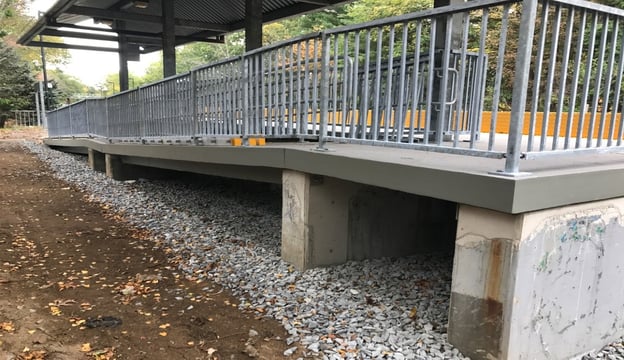
Earlier this month, we held a webinar where I spoke for the first time about Fiber Reinforced Polymer (FRP) rail platforms. It’s an exciting application for composite material because the industry’s aging infrastructure needs a robust, low maintenance, corrosion-resistant alternative.
This is where FiberSPAN-R enters the picture. We've been able to replace conventional rail platforms and manufacture mini-high platforms to aid individuals with disabilities during boarding of commuter trains, all using FiberSPAN-R. During the well-attended webinar mentioned above, I was asked several questions on the product which I discuss below.
Thanks to everyone who attended the webinar, and to those who submitted the following questions. If you have a question that's not covered here, contact me anytime.
1. Were the grates for the scupper on the mini-high platform also FRP?Yes, the grates are FRP. Composite Advantage does not make these. We buy from other FRP suppliers who specialize in grating. The grates are ADA compliant.
2. What type of corrosion protection is provided for the connection clips that connect to the beams?We use stainless steel for the connection clips and embedded steel inside the FRP panels. Because our product has a 100-year life cycle, stainless steel was the obvious material choice. Stainless is also fairly cost efficient.
3. How do you deal with non-proprietary requirements with FTA?The specifications need to be performance-based versus prescriptive. There are multiple suppliers of FRP platform panels but I feel FiberSPAN-R panels offer design features and value adds that are superior.
4. What type of performance specifications can you provide?We provide performance specification samples as a Word document that an engineer or owner can edit.
5. How do you prevent water and snow melt from reaching the steel support beams underneath?
We bond a small 3/8 in. by 1/2 in. drip strip to the bottom of the panel just slightly back from the edge. When water runs around the edge of the panel, it hits the strip and cannot wick back to the steel support structure.
6. Did "high" transfer force from the railing into panels prevent the use of a FRP railing/handrail?
FRP base plates can handle basic loads. If the loads are higher, stainless steel base plates are needed. Typically, structures used by the general public have not employed FRP railings because they look more “industrial.” Designers go with the same railings used on the concrete platforms.
Stay tuned for more about this topic in the coming months. Want to learn more about FRP rail platforms? Access my presentation or drop me an email. And if you ride a commuter train, who knows? You may one day find yourself standing on an FRP platform.
